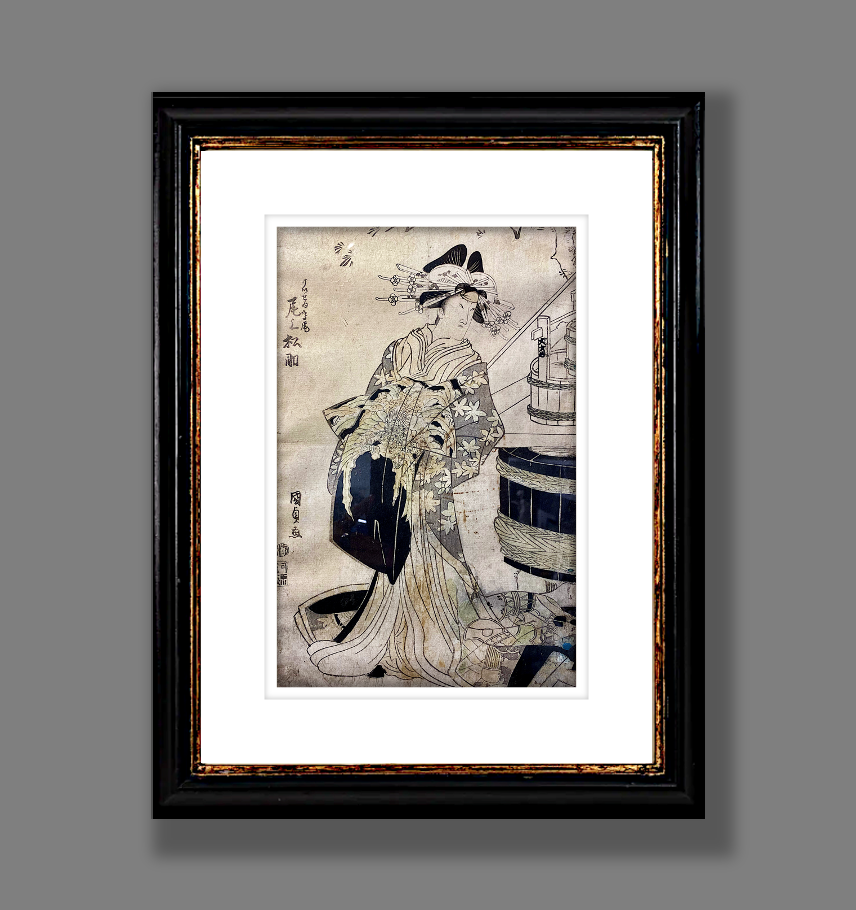

Title: Rare Japanese antique woodblock print of a geisha woman
Shipping: $29.00
Artist: N/A
Period: 18th Century
History: Art
Origin: Central Asia > Japan
Condition: N/A
Item Date: N/A
Item ID: 480
This is a rare 18th-century antique woodblock print of a Japanese geisha woman, created on handmade paper. The print features exquisite lines that showcase the mastery of the artist, who was a skilled craftsman and artist. Although the print is in poor condition, its beauty lies in its washed-out look, which is a result of the sun's powerful rays over the past 300 years. Despite this, hints of its original colors can still be seen, and the paper and patina of the image have a beautiful quality. It's considered in poor condition but still has a very strong graphic presence. Approximate image size 15 x 9. The history of an 18th-century Japanese woodblock print depicting a geisha woman is rich and intriguing. This particular print was created using a traditional woodblock printing technique, where the image was carved onto a wooden block, inked, and then pressed onto handmade paper to create the final artwork. During the 18th century in Japan, woodblock prints were a popular form of artistic expression, serving various purposes such as entertainment, advertisement, and cultural commentary. This particular print likely depicts a geisha woman, who was a professional entertainer and artist in Japanese society known for her skills in traditional arts, music, dance, and conversation. The print's exquisite lines reveal the mastery of the artist, who was a skilled craftsman and artist. Woodblock printing required precision and expertise in carving the intricate details onto the wooden block, as well as skillful application of ink and pressure to achieve the desired outcome. Over the years, this woodblock print may have been exposed to the elements, resulting in its current poor condition. However, its weathered appearance, washed-out look, and hints of its original colors that can still be seen are a testament to the passage of time and the sun's powerful rays that have affected the print over the last 300 years. Despite its condition, the print's paper and patina still exude a beautiful quality. The handmade paper used in traditional Japanese woodblock printing was often made from mulberry bark or other natural fibers, giving it a unique texture and durability. The patina, or aged appearance, of the print, adds to its charm and character, reflecting the passage of time and the history it has witnessed. In conclusion, this 18th-century Japanese woodblock print depicting a geisha woman is not just a piece of art, but also a window into the cultural and artistic heritage of Japan during that era. Its exquisite lines, masterful craftsmanship, and weathered appearance all contribute to its historical significance and aesthetic appeal, making it a valuable and intriguing artifact from Japan's rich artistic legacy.
During the 17th century in Japan, woodblock prints were created using a labor-intensive and meticulous process that required skilled craftsmen and artists. Here's an overview of the typical process and style of creating woodblock prints during that time: Design: The first step in creating a woodblock print was the design. An artist would sketch the image onto paper, which would then be handed over to a woodblock carver. Woodblock carving: A skilled woodblock carver would then transfer the design from the paper to a wooden block, typically made from cherry or pear wood. The carver would use chisels and knives to meticulously carve away the negative spaces of the design, leaving the raised areas that would be inked and printed. Printing: Once the woodblock was carved, the printer would apply ink to the raised surface of the block using a brush or roller. The paper, typically made from mulberry bark or other natural fibers, would then be carefully placed on top of the inked block and rubbed with a baren (a flat tool) or a wooden spoon to transfer the ink onto the paper, creating the print. Multiple blocks could be used for different colors, with each block carved and printed separately to achieve the final multicolor print. Hand-coloring: After the printing process, some woodblock prints were hand-colored to add further detail and vibrancy. This was typically done using watercolors or pigments applied with brushes by skilled artists. Style: Woodblock prints from the 17th century were often characterized by bold lines, intricate details, and a limited color palette. The style of woodblock prints during this time varied depending on the genre, such as landscapes, portraits, or ukiyo-e (pictures of the floating world) which depicted scenes of daily life, entertainment, and popular culture. Editions: Woodblock prints were typically produced in limited editions, with each print considered an original artwork. The prints were often signed by the artist, indicating their authenticity and value. Distribution: Woodblock prints were sold mainly in urban centers, where they were popular among a wide range of customers, from commoners to wealthy merchants and samurai. They were often used for advertisement, entertainment, and cultural commentary, and were considered a form of mass media during that time. In conclusion, the process of creating woodblock prints during the 17th century in Japan involved intricate carving, careful printing, and often hand-coloring, resulting in unique and highly valued artworks. The style of woodblock prints from this era was characterized by bold lines, intricate details, and limited colors, and they were widely distributed and appreciated as a form of artistic expression and cultural reflection.